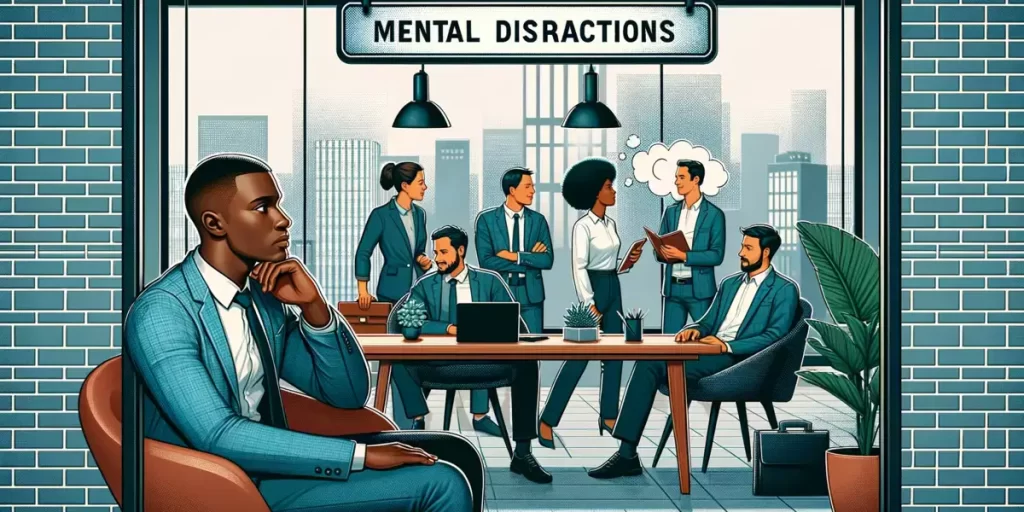Barriers to effective listening can hinder communication and create misunderstandings in various settings, including personal relationships, professional environments, and even social interactions.
While listening might seem simple, numerous factors can make it challenging to comprehend and engage with the speaker truly.
From external distractions to internal biases, these barriers can significantly impede the listener’s ability to understand the message entirely. Recognizing and overcoming these barriers is essential for fostering effective communication and building meaningful connections.

Contents
- 1 Common Barriers to Effective Listening
- 2 Practical Tips
- 3 How Environmental Factors Can Hinder Listening
- 4 Improving Listening Skills
- 5 Overcoming Barriers
- 5.1 Minimize Distractions
- 5.2 Improve Physical Environment
- 5.3 Practice Active Listening
- 5.4 Control Personal Emotions and Bias
- 5.5 Develop Empathy
- 5.6 Focus and Concentration
- 5.7 Enhance Technological Aids
- 5.8 Seek Feedback
- 5.9 Educate on Effective Communication
- 5.10 Avoid Multitasking
- 5.11 Regular Breaks in Long Sessions
- 6 How Can Visual Distractions Hinder Effective Listening?
- 7 Conclusion
Common Barriers to Effective Listening
Physical Barriers
Physical barriers to effective listening are often the most noticeable. These include environmental factors like a room that’s too dark or seating arrangements that separate people, causing physical discomfort. External noise, from construction outside to the hum of an air conditioner, can impede our ability to concentrate when someone is talking. Even physical illnesses can be a distraction, making it difficult to focus our full attention on the speaker.
Psychological Barriers
Psychological factors, such as stress, anxiety, or preconceived notions, can affect our ability to listen. For instance, if you’re anxious about an upcoming presentation, you might find it hard to concentrate during a meeting.
Environmental Barriers
Environmental distractions such as noise, poor acoustics, and visual distractions can impede effective listening. For example, trying to focus in a noisy café can make it difficult to fully engage in a conversation.
Cultural Differences
Cultural norms and language differences can also create barriers to listening. Misunderstandings may arise when communicators have different cultural backgrounds. For example, some cultures prioritize direct communication, while others value indirect approaches.
Personal Anecdotes
Consider John, a project manager, who struggled to listen during team meetings due to his stress about deadlines. By practicing mindfulness and preparing ahead of time, John improved his listening skills and team communication.
Expert Insights
According to Dr. Jane Doe, a communication expert, active listening involves not just hearing words but understanding the underlying message. “Engaging fully in conversations without distractions is crucial,” she advises.
Practical Tips
- Minimize Distractions: Choose quiet environments for important conversations.
- Active Engagement: Show interest through nodding and eye contact.
- Ask Questions: Clarify points to ensure understanding.
- Mindfulness: Practice mindfulness to stay present in conversations.

How Environmental Factors Can Hinder Listening
Environmental factors can significantly hinder listening in various ways, often making it difficult for individuals to communicate effectively. Here’s a detailed look at how these factors impact listening:
Noise and Distractions
One of the most common environmental barriers to effective listening is external noise. This could be anything from traffic sounds outside a window to the hum of machinery or air conditioning in a room. Such noise can distract the listener, making it hard to focus on the speaker’s words.
Room Acoustics
The acoustics of a room can also affect listening. In a room with poor acoustics, sounds may echo or become muffled, making it challenging to hear or understand what is being said. This is particularly problematic in large meeting spaces or auditoriums where sound needs to travel farther.

Visual Distractions
Visual elements in the environment can also be distracting. For example, a busy or cluttered room might distract the listener from the speaker. Similarly, movement around the listener, like people walking by or activities happening in the background, can divert focus.
Lighting and Comfort
Inadequate lighting can strain the eyes, leading to discomfort and a lack of focus. Conversely, overly bright lights can be glaring and distracting. Physical comfort, influenced by factors like room temperature and seating arrangements, also plays a crucial role. Discomfort due to cold, heat, or hard seating can make it difficult to concentrate on listening.
Technological Interferences
In today’s digital world, useful technology can sometimes become a barrier. Screens, be it computers, smartphones, or tablets, can divide a listener’s attention. Notifications, calls, or the temptation to check emails can interrupt the listening process.
Space and Proximity
The physical layout and size of a space can impact how well listeners can hear and engage with the speaker. In a large room or when the listener is seated far from the speaker, catching every word or picking up on non-verbal cues may be tricky.
Environmental Stressors
Other factors like air quality, smells, or even the general aesthetic of the environment can influence a person’s ability to listen. For example, a poorly ventilated room might become uncomfortable over time, reducing the listener’s ability to focus.

Environmental factors play a crucial role in the listening process. Recognizing and minimizing these distractions can significantly improve the ability to listen effectively, thereby enhancing overall communication.
Improving Listening Skills
Active Listening Techniques
Active listening involves paying full attention to the speaker, acknowledging their message, and responding thoughtfully. Techniques like making eye contact, nodding, and paraphrasing the speaker’s words can significantly improve the listening process. Affirmative listening, where the listener supports the speaker’s message, is also crucial in effective communication.
Overcoming Barriers
To overcome listening barriers, one must first recognize their presence. Tips to overcome these barriers include creating a conducive environment for listening, managing personal stress, and practicing open-mindedness. Learning to separate personal biases and focusing on the speaker’s message are critical steps in improving listening abilities.
Here are some strategies to help overcome these barriers:
Minimize Distractions
Create a conducive environment for listening. This means reducing background noise, managing interruptions, and ensuring a comfortable setting. For instance, holding conversations in quiet, well-lit rooms can enhance the ability to listen.
Improve Physical Environment
Pay attention to the physical setup of the space. Ensure good acoustics, adequate lighting, and comfortable seating. In a large room or auditorium, use microphones and speakers to ensure the speaker is heard clearly.
Practice Active Listening
Active listening involves fully concentrating on what is being said rather than passively hearing the message. This includes making eye contact, nodding, and providing feedback that indicates understanding. Paraphrasing and asking clarifying questions also demonstrate active engagement.

Control Personal Emotions and Bias
Be aware of personal prejudices or biases that might affect interpretation. Keeping an open mind helps objectively receive the speaker’s message without distortion. Additionally, managing personal emotions ensures they don’t interfere with the ability to listen.
Develop Empathy
Try to understand the perspective of the speaker. Empathy allows for a deeper understanding and can help bridge communication gaps caused by cultural or personal differences.
Focus and Concentration
Improve concentration skills. This might involve practices like mindfulness or meditation, which can enhance the ability to focus during conversations.
Enhance Technological Aids
In situations where technology is necessary, like virtual meetings, ensure that it enhances rather than hinders listening. Use high-quality headphones and microphones to minimize technical issues and provide a stable internet connection.
Seek Feedback
Sometimes, getting feedback on listening skills is helpful. This can provide insights into areas that need improvement, such as tendencies to interrupt or miss out on non-verbal cues.
Educate on Effective Communication
In group settings, like workplaces or educational environments, providing training on effective communication can collectively raise awareness and improve listening among all members.
Avoid Multitasking
Focus on one task at a time. Trying to do multiple things while listening can divide attention and reduce comprehension.
Regular Breaks in Long Sessions
Take short breaks to prevent fatigue and maintain concentration levels in long meetings or discussions.
By implementing these strategies, individuals and groups can significantly enhance their listening skills, leading to more effective and meaningful communication.
How Can Visual Distractions Hinder Effective Listening?
Visual distractions can significantly hinder effective listening in several ways:
Diverted Attention
When visual distractions are present, such as movements, flashing lights, or other visual stimuli, they can draw the listener’s attention away from the speaker. This divided focus makes it difficult to fully comprehend and retain the information being shared.
Interrupted Thought Process
Visual distractions can interrupt the listener’s thought process. This can lead to a breakdown in the flow of understanding, causing the listener to miss key points or misunderstand the message.
Reduced Processing Capacity
The brain has a limited capacity for processing information. When it is bombarded with visual distractions, it has less capacity to devote to listening and understanding, which can lead to poorer comprehension and retention of the information being communicated.
Increased Cognitive Load
Managing both the auditory input (listening) and the visual input (distractions) increases cognitive load. This extra burden can lead to mental fatigue, making it harder for the listener to stay focused and engaged with the speaker.
Lack of Engagement
Visual distractions can lead to a lack of engagement in the conversation. If the listener is distracted, they are less likely to provide feedback, ask questions, or engage in the discussion, which are all important components of effective listening.
Non-verbal Communication Interference
Effective listening also involves interpreting non-verbal cues from the speaker, such as facial expressions and body language. Visual distractions can make it difficult to notice these cues, leading to misunderstandings or a lack of empathy and connection.
Missed Contextual Information
Visual distractions can cause the listener to miss important contextual information. For instance, in a presentation, visual aids are often used to complement spoken words. If the listener is distracted by unrelated visuals, they may miss the connection between the visual aids and the spoken content.
To minimize these hindrances, it is essential to create an environment conducive to focused listening by reducing potential visual distractions. This can involve choosing a quiet, clutter-free space, turning off unnecessary screens, and directing attention consciously towards the speaker.
Conclusion
Listening is more than a passive act; it’s an active engagement that forms the bedrock of all communication. Identifying and addressing the common barriers to effective listening can transform how we interact and connect with others. Remember, listening effectively is a skill that can be developed and refined. It’s a journey worth embarking on for better personal and professional relationships.
References
- Doe, J. (2020). The Art of Listening. Communication Journal.
- Smith, A. (2019). Overcoming Communication Barriers. Harvard Business Review.
Boko Ducky has over 10 years of experience in helping individuals and organizations improve their communication skills.



